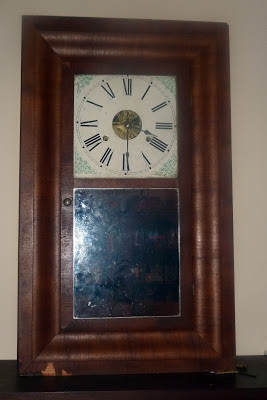 |
| Thomas Nelson's clock |
One day in 1878, or so the story goes, Thomas
Nelson hitched a horse to his wagon and rode the six miles into Waleska,
Georgia, a local center of trade. In Waleska he walked into a store and
purchased the clock that today is sitting on our living room mantel. The story
of Thomas' clock is part family lore and part history but worth knowing.
According to the 1870 U.S. Federal Census, Thomas and his wife Hannah were living
with his elderly parents, John and Elvira Nelson. Neither John nor Thomas
seemed to own any real estate, and Thomas' personal estate is valued at $400.
By the 1880 U.S. Federal Census, Thomas and Hannah were living in their own
household, had three sons, and Thomas was listed as a farmer. Although
their 1880 real and personal estate values are not given, the $4.50 he paid for
the clock probably represented a large amount to this Cherokee County
farming family. MeasuringWorth.com calculates that $4.50 price tag to be about $105 in today's currency.
Since Thomas farmed in the days when you got up with the sun and worked until dark, why would he purchase a clock? Was this a means of adding a touch of class to
their home, like putting curtains on the windows or using a lace
tablecloth? Had Thomas had a really good
crop that year and decided to purchase something for the family? Perhaps the clock had actually been purchased in 1880, the year both Thomas and Hannah would each have celebrated their 50th birthdays as well as their 25th anniversary. Maybe a
letter will surface someday, one written by Thomas or Hannah telling
us more about the clock's purchase. Until then, we can only
speculate.
The story my husband had always heard about Thomas' Clock was that it was passed
down to the youngest son. The next recipient of the clock, William
Nelson, however, was not the youngest child in Thomas and Hannah's family. There was a younger son, Samuel, born four
years after William. For reasons we may never know, the clock was
passed on to William who in turned passed it on to his youngest son, Jud, who
gave it to my husband, his youngest son. When we received the
clock about five years ago, we once again heard the story of Thomas'
Clock. Later, while traveling around Cherokee County,
Jud pointed out to my husband where the clock had been purchased. Like
the clock, the old building was still around.
My husband and I both have memories of Thomas'
Clock, even before it came to be in our home. For my husband, his most
vivid memories are of being a young boy, trying to sit still at his
grandparents' house on Sunday visits, listening to the ticking of the clock
when he would so much rather have been outside playing. I remember noticing
the clock sitting on his parent's kitchen mantel when I was visiting during our
courtship days. Later the clock was moved to a mantel in another room
where it continued to sit. Through the years something had happened to
the clock, for I had never heard it ticking back in those days. Even with some repair attempts by a friend,
Thomas' clock sat silently for a number of years at Jud's house.
After we received the clock, my husband and I wanted to learn more about the
clock itself. Thanks to the Internet, especially www.clockhistory.com, and several books from our
local library, we determined that the clock was a Seth Thomas 30-hour brass
weight driven clock in an Ogee case.
The clock has a Thomaston dial,
and the intact label printed by Thomaston Express
indicates that the clock was manufactured after 1865. One curiosity is
the word or name "Horn" written in large pencil script on the inside
wall of the case. From our research we also learned that this was a fairly common style of
clock, attractive with its simple case design, flat dial, and mirrored door. We were pleased when our tentative identification of the clock was confirmed by the clock repairman to whom we took it to be repaired.
Now the clock has been repaired. It sits on our mantel, periodically
dusted, and lovingly wound each night. The soft ticking is part of our
lives, a sound we immediately miss when we return home after being away for a
few days. Through the years it has
acquired several chips in its walnut veneer, but these nicks are just another
part of the story of Thomas' Clock. Someday Thomas' Clock will have a new
home with our younger son, and its story will continue.




